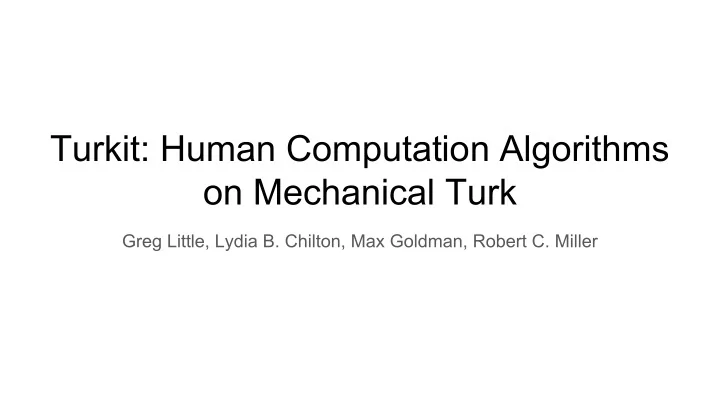

Turkit: Human Computation Algorithms on Mechanical Turk Greg Little, Lydia B. Chilton, Max Goldman, Robert C. Miller
Human computation Algorithms Tasks that build on each other.
Human computation Algorithms Tasks that build on each other.
Human computation Algorithms Tasks that build on each other. Iteration 1: Lightening strike in a blue sky near a tree and a building. Iteration 2: The image depicts a strike of fork lightening, striking a blue sky over a silhoutted building and trees. (4/5 votes) Iteration 3: The image depicts a strike of fork lightning, against a blue sky with a few white clouds over a silhouetted building and trees. (5/5 votes) Iteration 4: The image depicts a strike of fork lightning, against a blue sky- wonderful capture of the nature. (1/5 votes) Iteration 5: This image shows a large white strike of lightning com- ing down from a blue sky with the tops of the trees and rooftop peaking from the bottom. (3/5 votes) Iteration 6: This image shows a large white strike of lightning com- ing down from a blue sky with the silhouettes of tops of the trees and rooftop peeking from the bottom. The sky is a dark blue and the lightening is a contrasting bright white. The lightening has many arms of electricity coming off of it. (4/5 votes)
Crash-and-rerun programming model ● Model for when local computation is cheap and remote work is costly ● Managing states over a long running program is challenging ○ Examples: Computer restarts? Errors? ● Solution: store states in the database (in case) ● If an error happens, just crash the program and re-run by following the history in DB ○ Throw a “crash” exception; the script is automatically re-run. ● New keyword “once”: ○ Remove non-determinism ○ Don’t need to re-execute an expensive operation (when re-run) ● But why should we re-run???
Turkit Script Built on top of Javascript Supports the crash-and-rerun programming model Allows for simple parallelism via the fork and join operators. Provides wrapper functions for AMT REST API Building blocks Voting and Sorting Written in Java, using Rhino to interpret JavaScript code, and E4X to handle XML results from MTurk.
Turkit Script
Turkit Script
Turkit Script
Online Web Interface
Example Applications Iterative Writing
Example Applications Iterative Writing Blurry Text Recognition
Example Applications Iterative Writing Blurry Text Recognition Decision Theory Experimentation Psychophysics Experimentation
Performance Evaluations ● Dataset : Corpus of 20 TurKit experiments over a year ○ taks: iterative writing, blurry text recognition, website clustering, brainstorming, and photo sorting. ○ $364.85 for 29,731 assignments across 3,829 HITs. ● Round-trip-time for first assignment completion ○ avg. 4 min for $0.01 tasks,
Performance Evaluations ● Dataset : Corpus of 20 TurKit experiments over a year ○ taks: iterative writing, blurry text recognition, website clustering, brainstorming, and photo sorting. ○ $364.85 for 29,731 assignments across 3,829 HITs. ● Turkit execution time & memory consumption ○ At most takes 11 seconds to run full trace
Discussion Usability vs Scalability Parallel Programming Model Limitations Experimental Replication
Conclusion ● TurKit is a toolkit for exploring human computation algorithms on Mechanical Turk. ● Uses crash-and-rerun programming model for writing fault-tolerant scripts ● TurKit Script: An API for writing algorithmic MTurk tasks using crash-and- rerun programming. ● TurKit Online: A public web GUI for running and managing TurKit scripts. ● TurKit performance evaluated on a corpus of 20 scripts posting almost 30,000 tasks, shows its reasonably fast for most HITs
Recommend
More recommend